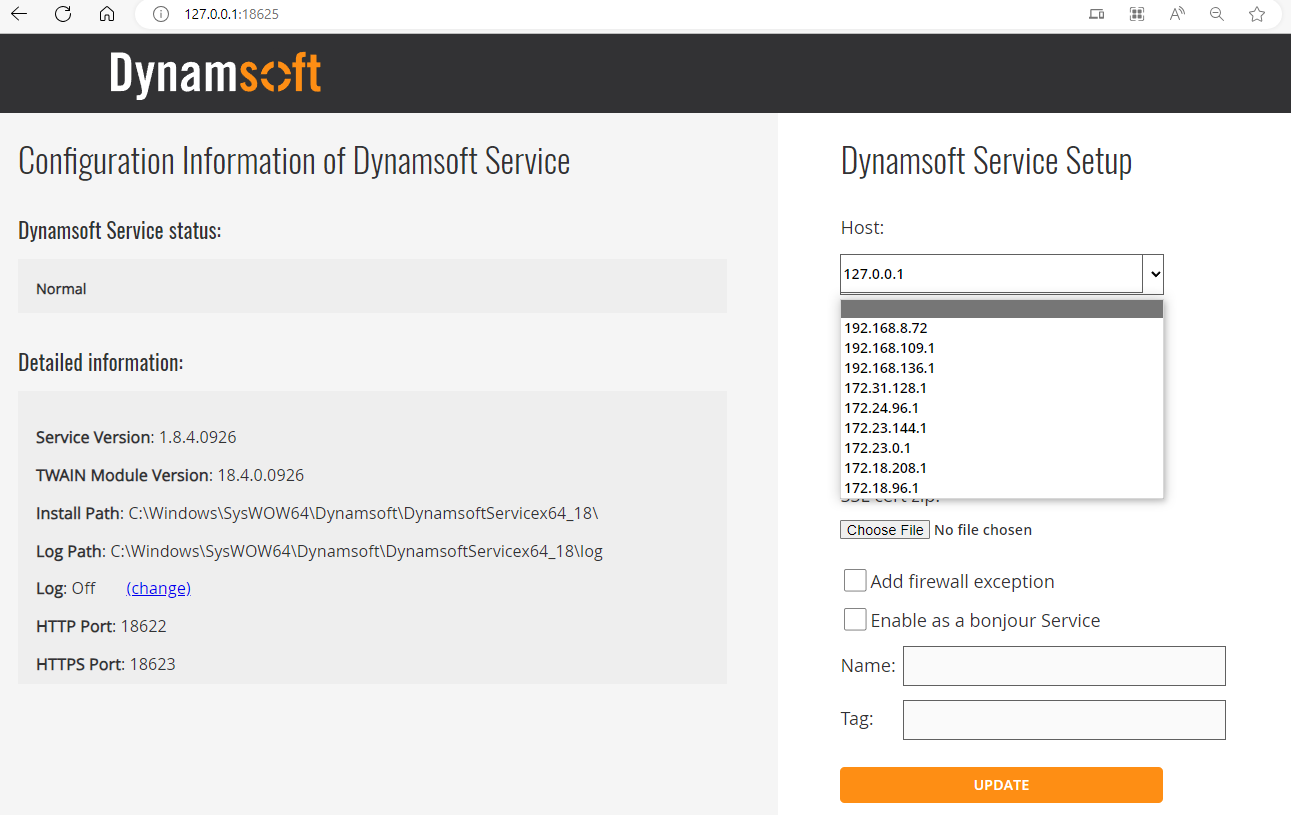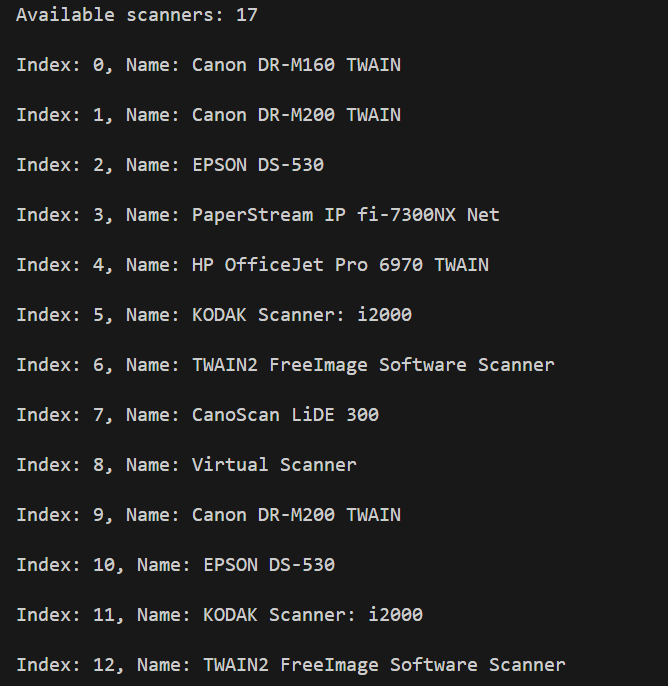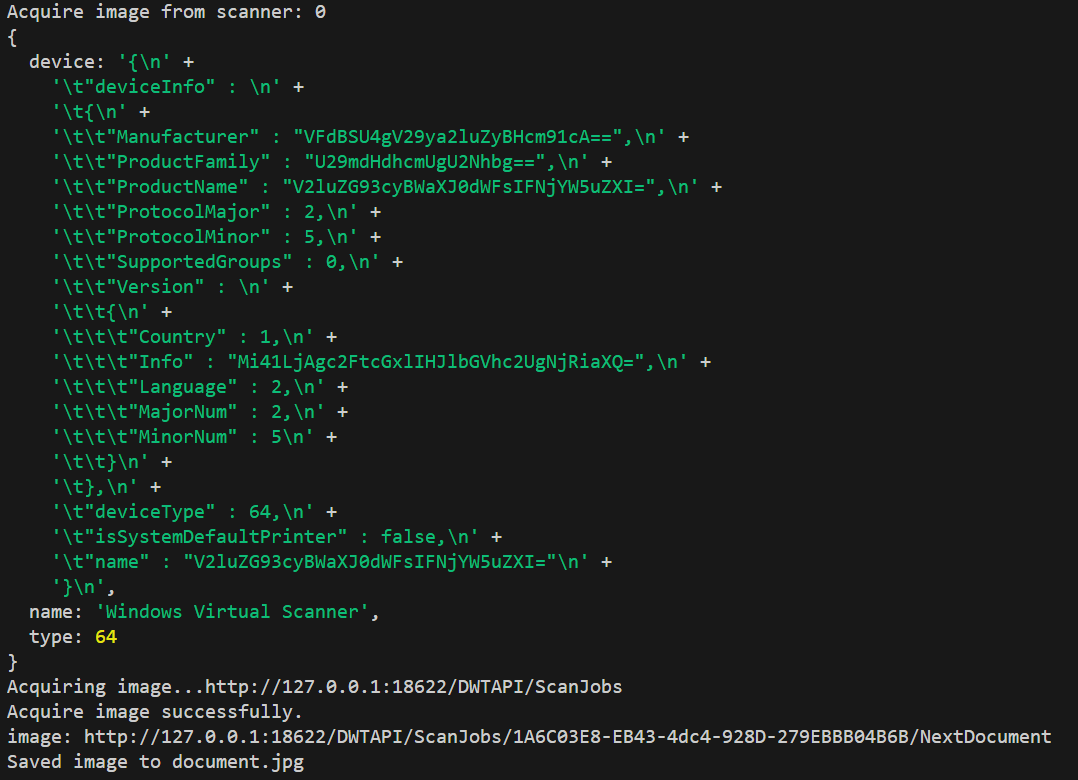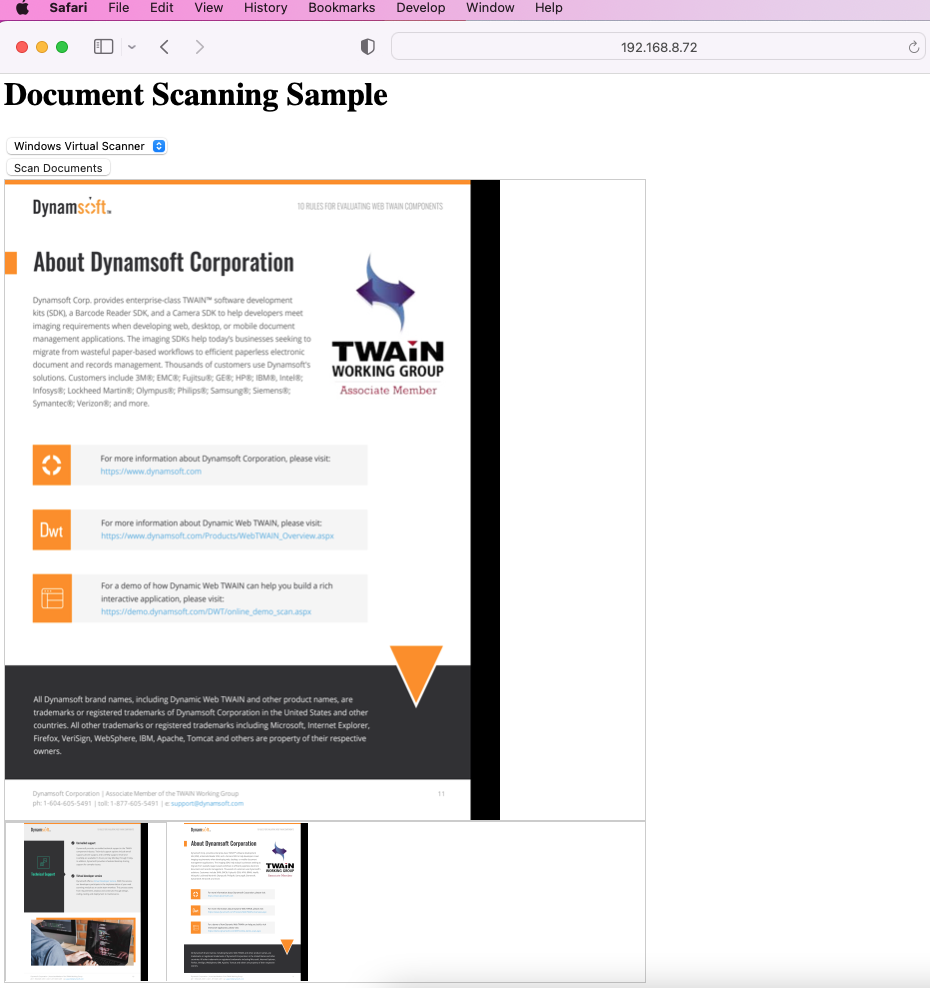Dynamic Web TWAIN Service REST API - Scan Documents in Node.js
Dynamsoft’s Web TWAIN SDK has long been a market leader in web-based document scanning, empowering numerous organizations to develop their own document management systems. The SDK consisted of two main components: a Dynamic Web TWAIN Service for scanner management and a JavaScript library for front-end development. Previously, this service could only be accessed via the JavaScript library. With the upcoming release, the Dynamic Web TWAIN Service will expose the core document scanning feature via REST API. This new feature enables developers to use various programming languages for document scanning tasks. Now, in addition to web-based applications, the SDK can also be used to create desktop and mobile document scanning apps, as well as server-side scanning services. In this article, I will guide you through the process of using the new REST API for document scanning in Node.js.
This article is Part 1 in a 8-Part Series.
- Part 1 - Dynamic Web TWAIN Service REST API - Scan Documents in Node.js
- Part 2 - Building a Document Digitization App with Flutter for TWAIN, WIA, and eSCL Scanners
- Part 3 - Access Document Scanners in Java
- Part 4 - How to Scan Documents from TWAIN, WIA, SANE Compatible Scanners in Python
- Part 5 - Building .NET Apps for Scanning Documents from TWAIN, WIA, SANE, and eSCL Scanners
- Part 6 - Scanning Documents to Web Pages with JavaScript and Dynamic Web TWAIN RESTful API
- Part 7 - How to Build a Remote Document Scanner in SwiftUI to Digitize Documents Over Network
- Part 8 - How to Scan Documents from Document Scanners Over a Local Network Using JavaScript and HTML5
NPM Package
https://www.npmjs.com/package/docscan4nodejs
Prerequisites
- Install Dynamic Web TWAIN Service.
- Request a free trial license for Dynamic Web TWAIN Service.
REST API Reference
https://www.dynamsoft.com/web-twain/docs/info/api/restful.html
By default, the REST API’s host address is set to http://127.0.0.1:18622. To modify this to a LAN IP address, navigate to http://127.0.0.1:18625/ in your web browser.

To control the scanner’s behavior, visit Dynamic Web TWAIN documentation for detailed information. For instance, you can set the resolution to 200 DPI and the pixel type to color:
let parameters = {
license: "LICENSE-KEY",
device: device,
};
parameters.config = {
IfShowUI: false,
PixelType: 2, // color
Resolution: 200,
IfFeederEnabled: false,
IfDuplexEnabled: false,
};
Developing Node.js Functions to Call the REST API
Install Axios for sending HTTP requests directly from Node.js to RESTful APIs and retrieve their responses.
npm install axios
According to the REST API reference, we implement five functions: getDevices(), scanDocument(), deleteJob, getImageFiles and getImageStreams().
const axios = require('axios');
const fs = require('fs');
const path = require('path');
module.exports = {
getDevices: async function (host) {
return [];
},
createJob: async function (host, parameters) {
return '';
},
deleteJob: async function (host, jobId) {
},
getImageFiles: async function (host, jobId, directory) {
let images = [];
return images;
},
getImageStreams: async function (host, jobId) {
let streams = [];
return streams;
},
};
-
getDevices()retrieves a list of scanners.async function getDevices(host, scannerType) { let url = `${host}/api/device/scanners`; if (scannerType != null) url += `?type=${scannerType}`; try { const response = await request({ url, method: 'GET', json: true }); if (response.data.length > 0) { return response.data; } } catch (error) { console.error('Device discovery failed:', error.message); } return []; } -
createJob()creates a scan job and returns its ID.async function createJob(host, parameters) { const url = `${host}/api/device/scanners/jobs`; try { const response = await request({ url, method: 'POST', headers: { 'DWT-PRODUCT-KEY': parameters.license, 'Content-Type': 'application/json', 'Content-Length': Buffer.byteLength(JSON.stringify(parameters)) }, json: true, body: parameters }); if (response.status !== 201) { console.log('Job created:', response); } return response.data; } catch (error) { console.error('Scan job creation failed:', error.message); return ''; } } -
deleteJob()deletes a scan job.async function deleteJob(host, jobId) { if (!jobId) return; const url = `${host}/api/device/scanners/jobs/${jobId}`; try { await request({ url, method: 'DELETE' }); } catch (error) { console.error('Job deletion failed:', error.message); } } -
getImageFiles()retrieves the image files of a scan job.async function getImageFiles(host, jobId, directory) { const images = []; console.log('Starting image download...'); while (true) { const filename = await getImageFile(host, jobId, directory); if (!filename) break; images.push(filename); } return images; } async function getImageFile(host, jobId, directory) { const url = `${host}/api/device/scanners/jobs/${jobId}/next-page`; try { const response = await request({ url, method: 'GET', stream: true }); if (response.status === 200) { return new Promise((resolve, reject) => { const filename = `image_${Date.now()}.jpg`; const imagePath = path.join(directory, filename); const writer = fs.createWriteStream(imagePath); // Pipe response stream to file response.stream.pipe(writer); // Handle successful write writer.on('finish', () => { resolve(filename); }); // Handle errors const handleError = (err) => { writer.destroy(); reject(err); }; writer.on('error', handleError); response.stream.on('error', handleError); // Handle timeout (30 seconds) const timeout = setTimeout(() => { handleError(new Error('Download timeout')); }, 30000); writer.on('close', () => clearTimeout(timeout)); }); } } catch (error) { console.error('Image download failed:', error.message); return ''; } } -
getImageStreams()retrieves the image streams of a scan job.async function getImageStreams(host, jobId) { const streams = []; while (true) { const stream = await getImageStream(host, jobId); if (!stream) break; streams.push(stream); } return streams; } async function getImageStream(host, jobId) { const url = `${host}/api/device/scanners/jobs/${jobId}/next-page`; try { const response = await request({ url, method: 'GET', stream: true }); if (response.status === 200) { return response.stream; } } catch (error) { console.error('Stream fetch failed:', error.message); } return null; }
Scanning Documents from the Command Line in Terminal
Let’s create a app.js file for scanning documents from the command line.
-
Import
docscan4nodejsandreadline. Thedocscan4nodejsmodule is what we just implemented, andreadlineis used to read user input from the command line.const docscan4nodejs = require("docscan4nodejs") const readline = require('readline'); -
Create a
readline.Interfaceinstance to read user input from the command line.const rl = readline.createInterface({ input: process.stdin, output: process.stdout }); rl.question(questions, function (answer) {}); -
Get all available scanners that compatible with TWAIN, SANE, ICA, WIA, and eSCL.
let devices = await docscan4nodejs.getDevices(host); -
Select a scanner from the list for scanning documents. A valid license key is required.
let parameters = { license: "LICENSE-KEY", device: devices[index].device, }; parameters.config = { IfShowUI: false, PixelType: 2, //XferCount: 1, //PageSize: 1, Resolution: 200, IfFeederEnabled: false, IfDuplexEnabled: false, }; docscan4nodejs.scanDocument(host, parameters).then((jobId) => { if (jobId !== '') { console.log('job id: ' + jobId); (async () => { let images = await docscan4nodejs.getImageFiles(host, jobId, './'); for (let i = 0; i < images.length; i++) { console.log('Image ' + i + ': ' + images[i]); } await docscan4nodejs.deleteJob(jobId); })(); } }); -
Run the script in the terminal.
node app.jsGet all available scanners

Acquire a Document

Implementing Server-side Document Scanning for Web-Based Applications
A more advanced use case involves implementing server-side document scanning for web-based applications. The key benefit of this strategy is that it enables document scanning directly from a web browser, eliminating the need for additional software installations. For instance, if your office has a single document scanner and you wish to share it among multiple colleagues, a web-based application would allow them to initiate scans from their individual computers.
We use express to create a web server and socket.io to transmit data between the server and the client.
npm install express socket.io
Node.js Web Server
-
Initialize
expressandsocket.io.const express = require('express'); const path = require('path'); const fs = require('fs'); const app = express(); const http = require('http'); const server = http.createServer(app); const io = require('socket.io')(server); const docscan4nodejs = require("docscan4nodejs") const { PassThrough } = require('stream'); app.use(express.static('public')); app.use('/node_modules', express.static(__dirname + '/node_modules')); const connections = new Map(); io.on('connection', (socket) => { connections.set(socket.id, socket); console.log(socket.id + ' connected'); socket.on('disconnect', () => { console.log(socket.id + ' disconnected'); connections.delete(socket.id); }); socket.on('message', async (message) => { }); }); // Start the server const port = process.env.PORT || 3000; server.listen(port, '0.0.0.0', () => { console.log(`Server running at http://0.0.0.0:${port}/`); }); -
As the
socket.ioconnection is established, get the available scanners and send them to the client.io.on('connection', (socket) => { ... docscan4nodejs.getDevices(host).then((scanners) => { socket.emit('message', JSON.stringify({ 'devices': scanners })); }); }); -
When receiving the scan event, initiate a document scan and transmit the resulting image stream to the web client:
socket.on('message', async (message) => { let json = JSON.parse(message); if (json) { if (json['scan']) { console.log('device: ' + json['scan']); let parameters = { license: "LICENSE-KEY", device: json['scan'], }; parameters.config = { IfShowUI: false, PixelType: 2, //XferCount: 1, //PageSize: 1, Resolution: 200, IfFeederEnabled: false, IfDuplexEnabled: false, }; let jobId = await docscan4nodejs.scanDocument(host, parameters); if (jobId !== '') { console.log('job id: ' + jobId); let streams = await docscan4nodejs.getImageStreams(host, jobId); for (let i = 0; i < streams.length; i++) { await new Promise((resolve, reject) => { try { const passThrough = new PassThrough(); const chunks = []; streams[i].pipe(passThrough); passThrough.on('data', (chunk) => { chunks.push(chunk); }); passThrough.on('end', () => { const buffer = Buffer.concat(chunks); socket.emit('image', buffer); resolve(); }); } catch (error) { reject(error); } }); } } } } });
Web Client
-
Establish a
socket.ioconnection with the server.const socket = io(); var data = []; var devices = []; var selectSources = document.getElementById("sources"); socket.on('message', (message) => { }); socket.on('image', (buffer) => { }); -
Update the
<select>element with the available scanners.socket.on('message', (message) => { try { let json = JSON.parse(message); if (json) { if (json['devices']) { selectSources.options.length = 0; devices = json['devices']; for (let i = 0; i < devices.length; i++) { console.log('\nIndex: ' + i + ', Name: ' + devices[i]['name']); let option = document.createElement("option"); option.text = devices[i]['name']; option.value = i.toString(); selectSources.add(option); } } } } catch (error) { console.log(error) } }); -
Send a scan event to the server when the user clicks the
Scanbutton.<button onclick="acquireImage()">Scan Documents</button> function acquireImage() { if (devices.length > 0 && selectSources.selectedIndex >= 0) { socket.emit('message', JSON.stringify({ 'scan': devices[selectSources.selectedIndex]['device'] })); } } -
Display the image stream in the
<img>element.socket.on('image', (buffer) => { // Convert the Buffer into a base64 string const base64Image = btoa( new Uint8Array(buffer) .reduce((data, byte) => data + String.fromCharCode(byte), '') ); // Set the image src to display the image let img = document.getElementById('document-image'); let url = `data:image/jpeg;base64,${base64Image}`; img.src = url; data.push(url); let option = document.createElement("option"); option.selected = true; option.text = url; option.value = url; let thumbnails = document.getElementById("thumb-box"); let newImage = document.createElement('img'); newImage.setAttribute('src', url); if (thumbnails != null) { thumbnails.appendChild(newImage); newImage.addEventListener('click', e => { if (e != null && e.target != null) { let target = e.target; img.src = target.src; } }); } });
Start the web server on your Windows machine, and then navigate to http://LAN-IP:18625/ using Safari on macOS.



